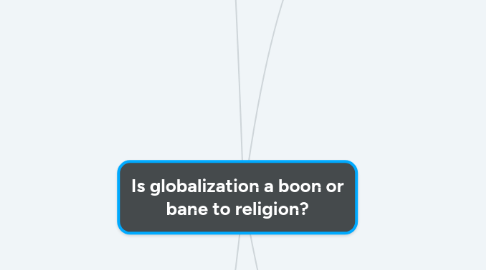
1. Advantages to Religion
1.1. Global Culture
1.1.1. Respect to other beliefs
1.1.2. Cultural and Religious Homogeneity
1.1.3. Entails liberal values and norms
1.2. Exploring complexities
1.2.1. Rediscovery of other beliefs
1.2.2. Open-mindedness
1.2.3. Hybridization
1.3. Interconnected relationship
1.3.1. Thrust people together
1.3.1.1. Mass Travel
1.3.1.2. Migration
1.3.1.3. Online
1.3.2. Sense of belongingness
1.3.3. Mutual tolerance
1.3.4. Sense of interaction
1.3.5. Deterritorialization
1.3.6. Connection through technology
1.3.7. Ideas of transworld
1.3.7.1. Global communication
1.3.7.2. Global organization
1.3.7.3. Global finance
1.4. Convenience
1.4.1. Urbanization to attract rural youth
1.5. Education
1.5.1. School's initiative to make interfaith dialogue
1.5.2. Faith lecture programs
1.5.3. Deeper knowledge about the role of religion
1.5.3.1. To embrace and practice the purpose and its nature
1.5.3.2. Many religious people reconcile reason and faith
1.6. Extended Influence
1.6.1. Myriad aspects
1.6.2. Faith grows in numbers
1.6.2.1. Immense good for people
1.6.2.2. Supporting the weak
1.6.2.3. Counselling
1.6.3. Dissemination of religious ideas
1.6.3.1. Information technology
1.6.3.2. Transportation
1.6.3.3. Media/Medium
1.6.3.3.1. Television
1.6.3.3.2. Radio station
1.6.3.3.3. Print media
1.6.3.4. Internet
1.6.4. Greater recognition to religion
2. Existing Barriers
2.1. Mentality
2.1.1. Self-consciousness of religions
2.1.2. Resistance to other religions
2.1.3. Fanaticism
2.1.4. Extremism
2.1.5. Single-mindedness
2.1.6. Anti-rationalist faith
2.1.7. Globalization as invasion
2.2. Inconvenience
2.2.1. Many rural populations are hard to reach
2.3. Preservation of one's culture and values
2.3.1. Religion as cultural protector
2.3.2. Overprotection of group values
2.4. Perceived Threats
2.4.1. Losing respective identities
2.4.2. Realistic and cultural perceived threats
2.4.3. Religious diversity
2.4.4. Hybridization
2.4.5. Losing respective morals
2.5. Incompatibility
2.5.1. Liberal values
2.5.2. Norms
2.5.3. Beliefs
2.5.4. Practice of worship
2.5.5. Consumerism
2.5.6. Nationalism
2.5.7. Liberalism
3. Disadvantages to Religion
3.1. Unsolidified Belief
3.1.1. More diversed
3.1.1.1. Increasing competition against other faiths
3.1.1.2. Additional sets of competitive symbolic claims
3.1.2. Interference of others to one's religious practices
3.2. Influence of Political impact
3.2.1. Greater legislations
3.2.2. Demands on restricting minority religions
3.3. Changes to identity
3.3.1. Core values
3.3.2. Norms
3.3.3. Network
3.3.4. Traditions
3.4. Unequal treatment
3.4.1. Religious discrimination
3.4.2. Discretion of faith
3.4.3. Unfair Restrictions
4. Arising Conflicts
4.1. Tension over reinforced social identities
4.1.1. Burqa Ban
4.1.2. Religious Fundamentalism
4.1.3. Religious terrorism
4.1.4. Religious wars
4.1.5. Horrible crimes against Humanity
4.2. Religious Freedom of the minority religions
4.2.1. Religious legislation
4.2.2. Religious discrimination
4.3. Effects of Hegemonic Religion
4.3.1. In-group bias
4.3.2. Ethnocentrism
4.3.3. Exclusionism
4.4. Erosion and Failure of Hybridity
4.4.1. Competitions
4.4.2. Revolution against modern secularism and scientism
